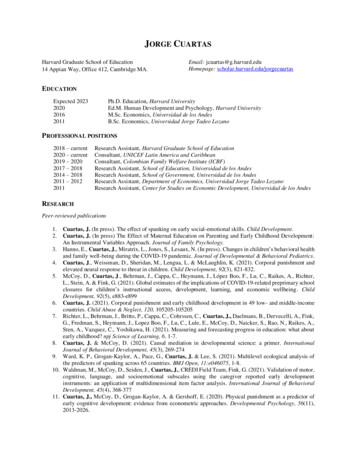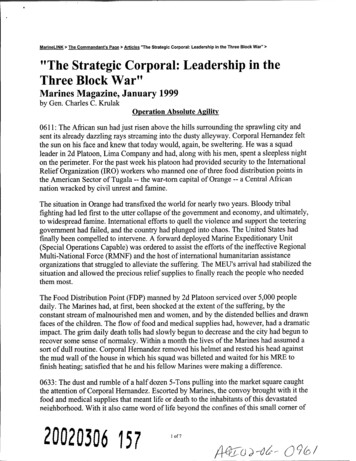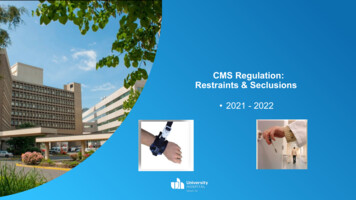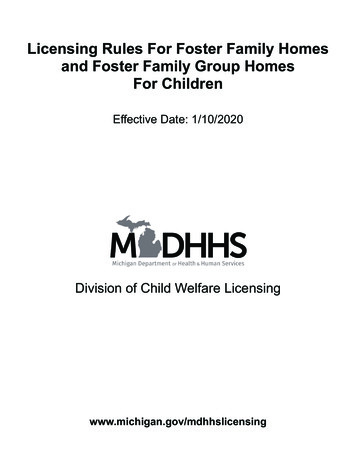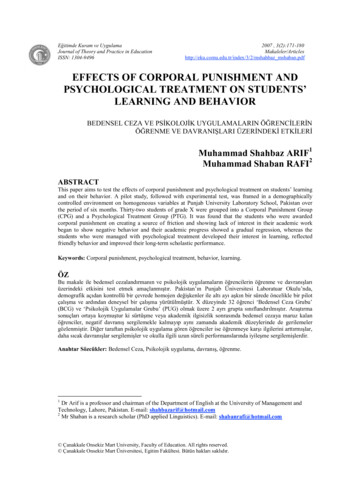
Transcription
Eğitimde Kuram ve UygulamaJournal of Theory and Practice in EducationISSN: 1304-94962007 , tr/index/3/2/mshahbaz mshaban.pdfEFFECTS OF CORPORAL PUNISHMENT ANDPSYCHOLOGICAL TREATMENT ON STUDENTS’LEARNING AND BEHAVIORBEDENSEL CEZA VE PSİKOLOJİK UYGULAMALARIN ÖĞRENCİLERİNÖĞRENME VE DAVRANIŞLARI ÜZERİNDEKİ ETKİLERİMuhammad Shahbaz ARIF1Muhammad Shaban RAFI2ABSTRACTThis paper aims to test the effects of corporal punishment and psychological treatment on students’ learningand on their behavior. A pilot study, followed with experimental test, was framed in a demographicallycontrolled environment on homogeneous variables at Punjab University Laboratory School, Pakistan overthe period of six months. Thirty-two students of grade X were grouped into a Corporal Punishment Group(CPG) and a Psychological Treatment Group (PTG). It was found that the students who were awardedcorporal punishment on creating a source of friction and showing lack of interest in their academic workbegan to show negative behavior and their academic progress showed a gradual regression, whereas thestudents who were managed with psychological treatment developed their interest in learning, reflectedfriendly behavior and improved their long-term scholastic performance.Keywords: Corporal punishment, psychological treatment, behavior, learning.ÖZBu makale ile bedensel cezalandırmanın ve psikolojik uygulamaların öğrencilerin öğrenme ve davranışlarıüzerindeki etkisini test etmek amaçlanmıştır. Pakistan’ın Punjab Üniversitesi Laboratuar Okulu’nda,demografik açıdan kontrollü bir çevrede homojen değişkenler ile altı ayı aşkın bir sürede öncelikle bir pilotçalışma ve ardından deneysel bir çalışma yürütülmüştür. X düzeyinde 32 öğrenci ‘Bedensel Ceza Grubu’(BCG) ve ‘Psikolojik Uygulamalar Grubu’ (PUG) olmak üzere 2 ayrı grupta sınıflandırılmıştır. Araştırmasonuçları ortaya koymuştur ki sürtüşme veya akademik ilgisizlik sonrasında bedensel cezaya maruz kalanöğrenciler, negatif davranış sergilemekle kalmayıp aynı zamanda akademik düzeylerinde de gerilemelergözlenmiştir. Diğer taraftan psikolojik uygulama gören öğrenciler ise öğrenmeye karşı ilgilerini arttırmışlar,daha sıcak davranışlar sergilemişler ve okulla ilgili uzun süreli performanslarında iyileşme sergilemişlerdir.Anahtar Sözcükler: Bedensel Ceza, Psikolojik uygulama, davranış, öğrenme.1Dr Arif is a professor and chairman of the Department of English at the University of Management andTechnology, Lahore, Pakistan. E-mail: shahbazarif@hotmail.com2Mr Shaban is a research scholar (PhD applied Linguistics). E-mail: shabanrafi@hotmail.com Çanakkale Onsekiz Mart University, Faculty of Education. All rights reserved. Çanakkale Onsekiz Mart Üniversitesi, Egitim Fakültesi. Bütün hakları saklıdır.
Effects Of Corporal Punishment And Psychological Treatment On Students’Learning And BehaviorINTRODUCTIONThe paper investigates the effects of corporal punishment and psychologicaltreatment on students’ learning and their behavior. Corporal punishment is apunitive act that inflicts pain. This includes hitting, slapping, spanking, or forcing achild to maintain an uncomfortable position.According to Graziano (1992), a frequent punishment has more to do with ateacher’s frustration level than with the child’s misbehavior. Many cases of childabuse result from an escalation of what starts off as "low level" hitting or spanking.Most child welfare organizations have policies opposing the use of corporalpunishment. Many educationists are against corporal punishment because of theaffront to the child’s dignity. Graziano (1990) stated, “If we are legally prohibitedfrom striking other adults, why is it okay to strike a child?” The previous researchesindicate that there are more reasons to oppose the use of corporal punishment andto support alternative disciplinary methods. In the long run, spanking does notwork; it carries with it many negative effects. The long-term use of corporalpunishment tends to increase the probability of deviant and antisocial behaviors,such as aggression; adolescent delinquency and violent acts inside and outside theschool (Straus, 1991). One explanation is that after living with violence that isconsidered ‘legitimate’, people expand this to accept violence that is not consideredlegitimate. For example, violent acts that are considered legitimate includemaintaining order in schools by punishing children, deterring criminals anddefending one’s country against foreign enemies. The “Cultural Spillover” theorypresented by Rohner (1991) proposes that the more a society uses force for sociallylegitimate ends, the greater the tendency for those who are involved in illegitimatebehaviors to use force to attain their own ends. Corporal punishment has beenassociated with a variety of psychological and behavioral disorders in children andadults, including anxiety, depression, withdrawal, low self-esteem, impulsiveness,delinquency and substance abuse (McCord, 1991).In Pakistan, steps have been initiated to discourage the teacher against theuse of corporal punishment. The Punjab education department announced thatincidents of corporal punishment in schools would not be tolerated and stern actionwould be taken against teachers who indulge in it under the Punjab Removal fromService Ordinance 2000 (Daily Times, 2005). Academicians, psychologists andexperts profoundly discourage the use of reprimand in the schools. They endorsepsychological treatments positive and negative reinforcement, time out, ignoringand tension decontamination through humor, token economy, response cost, overcorrection etc., to correct the negative behavior. It is assumed that increasing schoolviolence contributes to heavy physical punishment. Despite affirmation of antipunishment treaties by various countries, including Pakistan, in recent years, schoolshooting events and violence are on the rise. A horrifying school shooting incidentin Germany left 14 teachers, 2 students and a security guard dead when an expelledEgitimde Kuram ve Uygulama / Journal of Theory and Practice in Educationhttp://eku.comu.edu.tr/index/3/2/mshahbaz mshaban.pdf172
Muhammad Shahbaz ArifMuhammad Shaban RafiEgitimde Kuram veUygulamaJournal of Theory and Practice in Education2007 , 3(2):171-180former pupil went on a shooting spree at his school in the Eastern German city ofErfurt (BBC News, April 26, 2002). Among many other such incidents3, the mostrecent shooting rampage at the Virginia Tech University left 33 people deadincluding the suspected gunman (BBC, April 17, 2007). The apparent causes areunknown. It was reported that the killer was an abnormal and depressed person whowent on the rampage after having serious arguments with his girl friend. He wasreported many times for his behavior towards the students and teachers. This leadsus to an assumption that if the teachers had managed his ill behavior withpsychological treatment, he would not have caused this killing episode. We furtherassume that such on-campus shooting incidents are the result of teachers’classroom strategy failure to handle such type of depressed students.For the current research, thirty-two students of grade X were grouped intoCPG and PTG (16 students in each group). The research investigates the question:what are the effects of corporal punishment and psychological treatment onstudents’ learning and behavior? The research endeavors to probe a) whether or notcorporal punishment improves the students’ learning and behavior; b) whether ornot psychological treatment improves the students’ learning and behavior; c)average scholastic performance of CPG and PTG. The following hypotheses aredesigned to test these assumptions.HYPOTHESESH1: Corporal punishment corrects negative behavior; that is to say, whetheror not corporal punishment reinforces positive behavior.H2: Teachers’ classroom-strategies failure is the basic cause of school violence;that is to say, whether or not a wrongful classroom strategy creates a negative attitudeamong students, which shows itself in violence.H3: CPG scholastic performance is better than PTG; that is to say, whetheror not the Corporal Punishment Group scholastic performance is better than thePsychological Treatment Group.A BRIEF REVIEW OF LITERATUREMany countries such as Norway, Denmark and Finland have bannedcorporal punishment in schools, considering it a source of school violence(Larzelere, 1999).Previous researches pointed out that adults (parents and teachers) who werephysically punished in their childhood are more supportive of corporal punishmentthan those who were not subjected to physical punishment (Hyman, 1988).3A 15 year old schoolboy took one of his fellow classmates hostage in ‘Mull the Middle School’ USA onJanuary 13, 2006; a 25 year old student of Dawson College, Montreal killed a 20 year old student and leftmany injured on September 13, 2006; a 16 year schoolboy from Cored Lake High School shot dead hisgrandparents, 5 other students and a teacher on March 21, 2005, and so on. Çanakkale Onsekiz Mart University, Faculty of Education. All rights reserved. Çanakkale Onsekiz Mart Üniversitesi, Egitim Fakültesi. Bütün hakları saklıdır.173
Effects Of Corporal Punishment And Psychological Treatment On Students’Learning And BehaviorAccording to Gallup Organization (1995), it was noted that the parents hit 74% ofchildren under the age of 5 years. Ninety percent of parents spanked their childrenunder the age of 3 years (Wauchope, 1990). The approval of these parents tophysically discipline their own children leads to approval of such measures byschool authorities towards their students (Bauman, 1998). In a legal principlederived from English law of 1970, teachers are considered to be authority figuresthat may act like parents to discipline the child just as their parents do (Conte,2000).Children are better controlled, learn more appropriate appreciation forauthority, develop better social skills as well as improved moral character, andlearn better discipline when they are treated with psychological techniques. Thosewith this belief often feel that our teachers do not know how to keep properclassroom order and for many teachers physical punishment is the only techniqueleft to preserve academic control (Hyman, 1977). Climinillo (1988) proposed that“If corporal punishment is removed, that will trigger disciplinary difficulty inschools and will reduce teacher security”. The current legal / religious opinionsuggests that it is acceptable for parents to physically punish their children. It isthus fully acceptable for the teachers to act like parents (Conte, 1998). However, amajority of family physicians and pediatricians argue that corporal punishmentdoes not work to correct negative behavior permanently (Bauman, 1998).Previous researches discouraged the use of physical punishment to correct illbehavior in the schools, whereas some teachers are still forced to exact the toll ofpunishment to correct ill behavior in Pakistan.METHODOLOGYThirty-two students of grade X were grouped into CPG and PTG (16students in each group) on the basis of pre-test I and pre-test II. Data on targetedbehavior were elicited, observed and recorded through the administration of tasksand observation of situations, while the potential influence of other variables wascarefully controlled (following Bachman, 1996; J.D.Brown, 1996; Linn, 1989;Popham, 1981; Selinger, 1989). A pilot study, followed by an experimental test,was framed in a demographically controlled environment over homogeneousvariables in order to test the effects of corporal punishment and psychologicaltreatment on the students’ learning and on their behavior at Punjab UniversityLaboratory School, Pakistan over the period of six months. Data are attributedinitial construct-relevant meaning by the researcher classifying variations inobserved behaviors according to the range of previously identified criterial values;the score is summed from observations in a way that may be clearly linked tointended interpretation (Angoff, 1984; Bachman, 1996; Brindley, 1998; J.D.Brown,1996; Wright, 1999). Correct or wrong criterion was adopted from Makino(1980:124) and Cazden (1986:227). The reliability of scoring was also evaluated, inEgitimde Kuram ve Uygulama / Journal of Theory and Practice in Educationhttp://eku.comu.edu.tr/index/3/2/mshahbaz mshaban.pdf174
Muhammad Shahbaz ArifMuhammad Shaban RafiEgitimde Kuram veUygulamaJournal of Theory and Practice in Education2007 , 3(2):171-180order to establish the extent to which the score summaries represent systematicversus unknown or unintended sources of variability, by estimating classical andother sorts of reliability (Feldt, 1989; Hambleton, 1991; Orwin, 1994; Shavelson,1991; Traub, 1994). In the pilot study, two students of grade X were studied from agroup of 32 students on the basis of their equal grades in a test of English Literature& Grammar. Both of them were awarded physical punishment on creating acontinual source of friction and obtaining low grades. One of the students leftschool, while the other student was given psychological treatment and resultsshowed an improvement in his learning and behavior. Eventually, he developedteacher-friendly behavior and achieved above-average grades over the period of sixmonths. Two resource persons were purposefully selected to teach CPG and PTG.The subject matter - Home Work (HW) and Class Work (CW), was brought underdetail discussion to ensure validity. Individual scores and patterns of scores werecompared and summarized in the light of various categorical and probalisticproperties. Behavioral predictions from the construct definition stage (e.g., in theform of hypotheses) were evaluated using various techniques (J.D.Brown, 1988,1996; Hatch, 1991; Tabachnick, 1996; Woods, 1986). Mean, Standard Deviationand Student t-test was applied for the purpose of analysis at p .05 as significancethreshold. Any result in which the value of p is less than .05 is taken as statisticallysignificant.RESULTSIn the Pre-test I, the Mean Score of CPG (25.15) is smaller than PTG (26.15)as given in Table 1 below, whereas the Standard Deviation between the two Groupvariables is (2.32). In Pre-test II, the Mean Score of CPG (43.10) is smaller thanPTG (45.45), whereas the difference of Standard Deviation (5.35) is recordedamong the variables. PTG Mean Score (36.91) is greater than CPG Mean Score(25.30). But PTG S.D (1.06) is smaller than CPG Standard Deviation (2.32). ThePost-test shows the Mean difference of (11.61) between CPG and PTG scholasticperformance, whereas PTG shows (1.06) S.D within the group. This is less than theStandard Deviation of CPG (2.32) within the group. It is given in Table 1 below.Table 1: Scholastic Performance of CPG and PTGGroupNo. 5.1526.1543.1045.4525.3036.91TESTSPre- Test IPre- Test IIPost-TestMeanScoreDifference1.002.3511.61 Çanakkale Onsekiz Mart University, Faculty of Education. All rights reserved. Çanakkale Onsekiz Mart Üniversitesi, Egitim Fakültesi. Bütün hakları 21.062.325.351.26175
Effects Of Corporal Punishment And Psychological Treatment On Students’Learning And BehaviorFor convenience, Table 1 is presented in visual form in Figure 1 below.Mean Score (CPG & PTG)SCHOLASTIC PERFORMANCE OFCPG & re 1: Scholastic Performance of CPG & PTGTable 2 below shows that the percentage of CPG classroom participation isless than PTG. It also shows 95% PTG written tasks performance as compared withCPG 90%. The difference (p .05) of PTG is of borderline significance with theCPG. The difference is due to the result of punishment fear whereas PTG showedoverwhelming interest to complete its written assignments.Table 2: Percentage of CPG & PTG Written Work and Class ParticipationGroupCPGPercentage of WrittenPerformance90%Percentage of ClassroomParticipation10%PTG95%90%Table 2 is presented in Figure 2 below.PERCENTAGE OF CPG & PTG WRITTENWORK AND CLASS PTG20%10%10%CPGPTG0%CPGPTGWritten WorkCPGPTGClass ParticipationFigure 2: Percentage of CPG & PTG Written Work and Class ParticipationEgitimde Kuram ve Uygulama / Journal of Theory and Practice in Educationhttp://eku.comu.edu.tr/index/3/2/mshahbaz mshaban.pdf176
Muhammad Shahbaz ArifMuhammad Shaban RafiEgitimde Kuram veUygulamaJournal of Theory and Practice in Education2007 , 3(2):171-180DISCUSSIONTable 1, Figure 1 shows 11.61 mean score difference between CPG and PTGpost test scholastic performance. It signifies that the Psychological TreatmentGroup’s scholastic performance is better than the Corporal Punishment Group. Thefirst hypothesis (Corporal punishment corrects negative behavior) of the study wasrejected. It explains that psychological treatments correct the students’ ill behavior.The second hypothesis (Teachers’ classroom-strategies failure is the basic cause ofschool violence.) was accepted. It can be interpreted as meaning that on-campusshooting incidents are the result of teachers’ classroom-strategies failure to handledisturbed students. The third hypothesis (CPG scholastic performance is better thanPTG scholastic performance) was rejected. PTG was found to be filled withmotivation for learning and producing its written assignments. CPG showed lack ofinterest in teacher’s deliberate mistakes whereas PTG consciously pinpointed thosemistakes. CPG did not show the courage to ask for permission to go to thewashroom, get drinking water, or borrow ink, notebooks, pencils, and so on. CPGwas unaware of its teacher’s personal history while PTG showed curiosity to learnit. CPG was found to be planning to rebel against its teacher while PTG wasobserved to be seeking the opportunity to admire its teacher.CONCLUSIONThis paper analyzed the effects of corporal punishment and psychologicaltreatment on students’ learning and on their behavior. A significant difference at p 0.05 was found between the Corporal Punishment Group and the PsychologicalTreatment Group’s scholastic performance. Corporal punishment strengthens illbehavior; this tends to school violence in the long run. It indicates that childrenwho are subjected to corporal punishment are more likely to utilize violence in theirfamily and society in future whereas psychological treatment streamlines thestudents’ behavior for a longer period of time. Thus it opens the opportunity forlearning, and it improves students’ scholastic performance. Many students inPakistan fear attending school and many of those who seek admission later leavethe school due to physical punishment. It is assumed that later on they consent toenter the criminal world (that is; they become extremists, terrorists and offenders)to empower themselves in the hands of terrorism. If the teachers (who areobviously a catalyst for change) are stopped from using corporal punishment, it willbring a healthy change, contributing to a healthy society free from crime andterrorism. Çanakkale Onsekiz Mart University, Faculty of Education. All rights reserved. Çanakkale Onsekiz Mart Üniversitesi, Egitim Fakültesi. Bütün hakları saklıdır.177
Effects Of Corporal Punishment And Psychological Treatment On Students’Learning And BehaviorREFERENCESAngoff, W.H. (1984). Scales, Norms and Equivalent Scores: Princeton, NJ:Educational Testing Service.Bachman, L.F., and Palmer, A.S. (1996). Language Testing in Practice:Designing and Developing Useful Language Tests: Oxford UniversityPress.Bauman L.J., Friedman B. (1998). Corporal Punishment: Pediatric Clin NoAm.BBC News. (00:22 GMT, April 17, 2007). US University Shooting Kills .BBC News. (21:32 GMT, April 26, 2002). 18 Dead In German School .stm.Bindley, G. (1998). Describing Language Development? Rating Scales andSLA: Interface between Second Language Acquisition and LanguageTesting Research. Cambridge University Press, 40-112.Brown, J.D. (1996).Testing in Language Programs: Englewood Cliffs, NJ:Prentice-Hall.Brown, J.D. (1988).Understanding Research in Second Language Learning: ATeacher’s Guide to Statistics and Research Design. London: Heinemann.Cazden, C. (1986). Child language and education: New York: Holt, Rinehart &Winston.Climinillo LM. (1988) Discipline: The School’s Dilemma. Adolescence.Daily Times. (July 4, 2005). Staff Report, Corporal Punishment.Feldt, L.S.,and Brennan, R.L. (1989). Reliability, Educational Measurement: 3rdedition. New York: Macmillan, 46-105.Gallup Organization. (1995). Discipline Children in America: A Gallup PollReport. Princeton, NJ: Gallup Organization.Gershoff E.T. (2002). Corporal punishment by parents and associated childbehaviors and experiences: A meta-analytic and theoretical review, 14(2):490-495.Graziano, Anthony M., and Linda J. (1992). Effects of Corporal Punishment onChildren: Violence Update, 86(3):368-382.Graziano, Anthony M., and Namaste, Karen A. (July, 1990). Parental Use ofPhysical Force in Child Discipline: Journal of Interpersonal Violence, 5(4):43-50.Hambleton, R.K., Swaminathan, H.,and Rogers, H.J. (1991). Fundamentals ofItem Response theory: Newbury Park, CA: Sage.Hatch, E., and Lazaraton, A. (1991) The Research Manual: Design and Statisticsfor Applied Linguistics: New York: HarperCollins and Newbury House.Hyman I.A. (1988). Eliminating Corporal Punishment in Schools: Moving fromadvocacy research to policy implementation. Child Legal Rights,15(6):110-115.Egitimde Kuram ve Uygulama / Journal of Theory and Practice in Educationhttp://eku.comu.edu.tr/index/3/2/mshahbaz mshaban.pdf178
Muhammad Shahbaz ArifMuhammad Shaban RafiEgitimde Kuram veUygulamaJournal of Theory and Practice in Education2007 , 3(2):171-180Hyman I.A., McDowell E., and Rains B. (1977). Corporal Punishment andalternative in the schools: An overview of theoretical and practical issuesin National Institute of Education Preceding: Conference on CorporalPunishment in Schools: A National Debate February 18-20. U.S.Government Printing Office.Larzelere R.E. and Johnson B. (1999). Evaluation of the effects of Sweden’sspanking ban on physical child abuses: Psychology Rape, 12 (54):15-16.Linn, R.L. (ed.) (1989). Educational Measurement. 3rd edition New York:American Council on Education and Macmillan.Makino, T. (1979). English morpheme acquisition order of Japanese secondaryschool students: TESOL Quarterly, 43 (13): 124.McCord, J. (May, 1991). Questioning the Value of Punishment: Social Problems.38( 2):190-200.Orwin, R.G. (1994). Evaluating Coding Decisions: In H. Cooper and L.V. Hedges(eds), The Handbook of Research Synthesis. New York: Russell SageFoundation.Popham, W.J. (1981). Modern Educational Measurement: Englewood Cliffs, NJ:Prentice-Hall.Rohner, Ronald P., Kean, Kevin J., Cournoyer, David. (August, 1991). Effects ofCorporal Punishment, Perceived Caretaker Warmth, and Cultural Beliefs onthe Psychological Adjustment of Children in St. Kitts, West Indies: Journalof Marriage and the Family, 19 (25), 40-45.Shavelson, R.J. Webb, N.M. (1991). Generalizability Theory: A Primer. NewburyPark, CA; Sage.Selinger, H.W., Shohamy, E. (1989). Second Language Research Methods:Oxford University Press.Straus, Murray A. (May, 1991). Discipline and Deviance: Physical Punishment ofChildren and Violence and Other Crime in Adulthood: Social Problems 38(2):205-206Tabachnick, B.G., and Fidell, L.S. (1996).Using Multivariate Statistics: 3rdEdition. New York; Harper Collins.Traub, R.E. (1994). Reliability for the Social Sciences: Theory and Applications.Thousands Oaks, CA, Sage.Wauchope BA., and Straus MA. (1990).Physical punishment and physical abuseof American Children: Incidence rates by age, gender and occupationalclass. In: Straus MA Gelles RJ (eds).Physical Violence in AmericanFamilies. New Brunswick, NJ: Transaction.Woods, A., and Fletcher Hughes, A. (1986). Statistics in Language Studies: NewYork, Cambridge University Press. Çanakkale Onsekiz Mart University, Faculty of Education. All rights reserved. Çanakkale Onsekiz Mart Üniversitesi, Egitim Fakültesi. Bütün hakları saklıdır.179
Effects Of Corporal Punishment And Psychological Treatment On Students’Learning And BehaviorWright, B.D. (1999). Fundamental Measurement for Psychology. The NewRules of Measurement: What Every Psychologist and Educator shouldknow. Mahwah, NJ, Lawrence Erlbaum Associate.Egitimde Kuram ve Uygulama / Journal of Theory and Practice in Educationhttp://eku.comu.edu.tr/index/3/2/mshahbaz mshaban.pdf180
correction etc., to correct the negative behavior. It is assumed that increasing school violence contributes to heavy physical punishment. Despite affirmation of anti-punishment treaties by various countries, including Pakistan, in recent years, school shooting events and violence are on the rise. A horrifying school shooting incident
